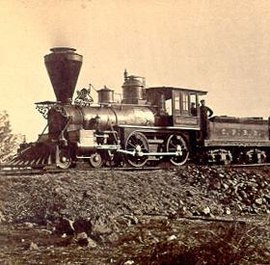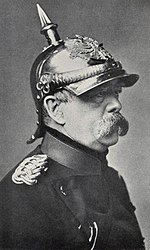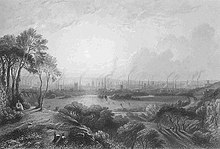XIX century
The 19th century d. C. (nineteenth century AD) or XIX century and. c. (nineteenth century CE) was the ninth century of the second millennium in the Gregorian calendar. It began on January 1, 1801 and ended on December 31, 1900. It is called the "century of industrialization".
The fundamental characteristic of this century is that it is a period of great changes. Science and economics would feed off each other, the term 'scientific', coined in 1833 by William Whewell, would be a fundamental part of the language of the time; the economy would suffer two strong industrial revolutions, the first between 1750 and 1840, and the second between 1880 and 1914. In politics, the new ideas of the previous century would lay the foundations for bourgeois revolutions, revolutions that would spread throughout the world through imperialism and would seek an alliance with the labor movement to which they would grant universal suffrage; in philosophy, the principles of most of the currents of contemporary thought would arise, currents such as absolute idealism, dialectical materialism, nihilism and nationalism; art would take time to start the avant-garde process but it would be based on movements such as impressionism. At the end of this century, cinematography and animation emerged thanks to the great technological advances of the time.
Science
Medicine
The development of medicine is directly related to migratory phenomena, overcrowding in cities and the precarious living conditions of the working class since the Industrial Revolution, infectious diseases (syphilis, tuberculosis) or those related to poor nutrition (pellagra, rickets, scurvy). These problems are crucial to understand the origin of Rudolf Virchow's social medicine and the birth of Edwin Chadwick's public health system that would give rise to the current preventive medicine. The Industrial Revolution itself, with the addition of numerous wars and revolutions, would generate a generalized scientific development that would contribute to the establishment of technical conditions for the triumph of asepsis, anesthesia and surgery.
The bourgeois revolutions, promoters of free-thinking citizens, build a new scientific and empirical medicine, detached from the mystical and artisanal. It culminates in the oppression of the old ethical canons of absolutism and Catholicism establishing new canons, new calendars. The XIX century will see the birth of Claude Bernard's experimental medicine, the theory of Omnia cellula a cellula Rudolf Virchow's, the microbial theory of disease, Charles Darwin's theory of evolution of species, and Gregor Mendel's genetics.
When microorganisms were identified as the cause of numerous diseases, medicine advanced enormously, much faster than at any previous time in history. When this was known, methods such as antibiotics and sterilization began to be used, in addition there began to be a considerable increase in hygiene, the nurse Florence Nightingale being the promoter of this. All these advances made life expectancy, which was only 30-40 years at the beginning of the XIX century, increased to 50 -60 years at the beginning of the XX century, being such a rapid and effective advance never before achieved in the history of medicine.
Historiography
The XIX century is characterized by a definitive break with the fusion that history had with literature. Leopold von Ranke commits to a critical and skeptical history. He allows himself to be influenced by the predominant philosophical currents of the moment, such as liberalism and nationalism, even falling into ethnocentrism, racism and particularly Eurocentrism. The reflections on the society of Saint-Simon produce two tendencies that would modify the historiographical tendencies: Positivism and historical materialism, also influenced by the Hegelian dialectic. Both understand that the behavior of history is subject to laws. The first conceives the development of history as ordered processes, the second conceives it as a result of conflicts between social strata.
Politics
Europe
In Europe the 19th century was characterized by the birth of census democracies and the decline of absolute monarchies. The French Revolution and the subsequent Napoleonic era would help spread republican and liberal ideas. The monarchs, in the case of surviving, would become enlightened despots who acted permissively with the ruling class. The idea of left and right would arise from the French Revolution. Politicians would be identified with Jean-Paul Marat and Maximilien Robespierre, or with the Comte de Mirabeau and the Marquis de La Fayette. The temporary decline of the revolutions in favor of the restoration of the monarchies would only be able to strengthen them in more radical revolutionary waves such as those of 1848, until the development of social ideologies and the labor movement, which would culminate in the triumph of the Russian Revolution in 1917..
Latin America
The emancipation of Latin America began in this century. The indigenous uprisings in the name of Túpac Amaru and the community members of Asunción would be antecedents of a nascent identity. Identity that would be born and would be defended by the great Latin American heroes, promoters of the idea of a Latin American nation: Francisco de Miranda, José María Morelos, José Miguel Carrera, Bernardo O'Higgins, José Joaquín de Olmedo, Francisco de Paula Santander, Camilo Torres, Antonio Nariño, Antonio José de Sucre, Simón Bolívar, José de San Martín, Mariano Moreno, Manuel Belgrano, José Gervasio Artigas and Juan Pablo Duarte. His revolution, constituted within the framework of the bourgeois revolutions, would be strictly Latin American. Their revolutions would fail largely because of caudillismos, interests of the local bourgeoisies and bribes from the European powers, but each one of them would be turned, often by those who betrayed them, into a legend. The American borders varied remarkably throughout the century and the governments would take a bipartisan structure where coups d'état and electoral fraud swarmed.
Imperialism
Africa would be openly used and abused by European empires. Cecil Rhodes would be a pivotal figure in the development of British imperialism. US imperialism would also slowly emerge from an apparently innocent Monroe Doctrine. That century would announce the decline of the Ottoman Empire that would occur with the First World War. The Opium Wars would humiliate the historic Chinese Empire in its unequal treaties and culminate in the fall of the Qing dynasty in 1911.
Art
Historicism marks the new architecture, which is influenced by the longing for the past, which finds its originality in the study of the past origin. He concentrated all his efforts on recovering the architecture of bygone times. The neoclassicism of the last century was followed by the neo-Gothic, associated with nationalist romantic ideals. The eclectic architecture makes the historicist evolve, combining a variety of architectural styles in a new structure.
The Arts and Crafts movement contemplated the idea of taking advantage of industrial and technological development, seeing in the craftsman a remarkable figure. With the dissolution of its ideals and the dispersion of its defenders, the ideas of the movement evolved, in the French context, towards the aesthetics of Art Nouveau, considered the last style of the century XIX and the first of the XX century.
The Romanticism of the 19th century was the antithesis of Neoclassicism. Moderation, rationalism, public immorality will be sharply replaced by excess, sentimentality, the search to create an increasingly unattainable morality. The ideals founded by Rousseau, the ideological precursor of romanticism, will culminate in the French Revolution, which would be the starting point for the creation of a new era. The revolution will be constantly evoked throughout the century, along with ideals such as freedom, independence and nationalism, then belonging to the political left. The pillars are bourgeois individualism, which would be reflected in literary subjectivism; the evasion of reality, in favor of the creation of a new, improved society; the exaltation of nature, in which they supposed that man was exempt from dramas and difficulties.
Towards post-romanticism, the idea that the beauty of art is found in art itself would emerge: Art for art's sake. Several currents are considered post-romantic: Parnassianism would be characterized by its break with subjectivism and excessive sentimentality; symbolism as defined by Jean Moréas himself is Enemy of teaching, declamation, false sensitivity, objective description”, it is impregnated with metaphysical intentions, mystery and mysticism; decadence arises from the act of empowering Baudelaire, who sought beauty in the disgusting.
Another alternative to romanticism was realism, inspired by the social effects of the new capitalism. The use of satire, denunciation, the themes of disease, dirt, madness, poverty, vices and prostitution is common. Realism would be enhanced in naturalism, more influenced by materialism, positivism or determinism.
The painting of the XIX century was not exempt from the historical break with its history. Neither was he of the multitude of currents of philosophy of art. He was also influenced by the French political phenomenon, the break with the traditional artist who shows what the monarchy and its aristocracy want. The world is not in order, and that is intended to show the new art, at the same time that it proposes a new order: Romanticism. Where neoclassicism proposes an ideal beauty, rationalism, virtue, line, the cult of classical Antiquity and the Mediterranean, romanticism opposes and promotes the heart, passion, the irrational, the imaginary, disorder, the exaltation, colour, brushstrokes and the cult of the Middle Ages and the mythologies of northern Europe.
Towards the middle of the century there is a return, in a way, to rationalism as a source of inspiration. The notorious industrial development caused by the Industrial Revolution, its "secondary effects" and the frustration with the revolutionary stimuli of 1848 lead the artist to forget about the political theme and to focus on the social theme. The realist manifesto understands that the only source of inspiration in art is reality, there is no kind of preconceived beauty beyond that provided by reality, and what the artist must do is reproduce this reality without embellishing it.
The English landscape painters of Romanticism would strengthen the foundations on which the Impressionists would later work. From Turner the Impressionists would take their taste for transience, their blurred and vaporous surfaces, the blurring and the mixture of intense colors; but they would discard the sublime component, typical of romantic painting.
Towards the end of the century and the beginning of the XX century, a great variety of avant-gardes could be seen. The peak of individualism implied that each artist should promote his own avant-garde, which he claimed to be universal and true. Post-impressionism, pointillism, pictorial symbolism, expressionism, cubism, fauvism, surrealism, futurism would give an account of a society that lives in revolution for revolution's sake, the avant-garde for the avant-garde, universality for universality. A society where deadlines are getting smaller, the pace getting faster.
Although it broke with harmonic moderation, Romanticism did not necessarily function as the antithesis of Classicism. Beethoven (1770-1827), which meant a link between both styles, developed principles inherited from Haydn in terms of contrast, while temporarily extending the sonata form. He took up the chromatic tonality by expanding it and going to the extreme, in post-romanticism, of suspending it or creating a generalized wandering tonality. The size of the orchestra was also increased, reaching utopian extremes such as that of Berlioz. In this century, the cult of the past would take shape, particularly Bach and the Baroque, for which reason interpretation would begin as a new branch. Towards the middle of the century, the role of nationalism as an aesthetic search would also be important.
Towards the end of the century, impressionism would take shape, which would seek its expression in the break with tonality, seeking modality as an archaic search form. He would also be inspired by "exotic" music, particularly gamelan music. It would break the contrast in favor of homogeneity even up to the concept of functional music, as in the case of Erik Satie's experimental piece Music of furniture.
While the modalism and scaling of impressionism would influence later modernist composers, an interest in music with minimal contrasts would influence minimalism. Post-romantic chromaticism, on the contrary, would exert more influence on expressionism, which would develop free atonalism and later twelve-tone.
Advances and developments
Science and technology
- The First Industrial Revolution causes profound changes in the economy and technology.
Advances in Medicine
- Discovery of puerperal sepsis by Ignác Semmelweis.
- Identification of microorganisms as cause of infectious diseases, by Louis Pasteur and Robert Koch.
Inventions
- Locomotive: Richard Trevithick, 1804.
- Photograph: Nicéphore Niepce, 1826.
- Electric vehicle: Robert Anderson, between 1832 and 1839 (the exact year is uncertain)
- Anesthesia: William Morton, 1846.
- Telephone: Antonio Meucci, 1854.
- Incandescent lamp: Heinrich Göbel, 1854.
- Margarine: Hippolyte Mège-Mouriés, 1860.
- Leader: Solomon Andrews, 1863.
- Clinical Thermometer: Thomas Clifford Allbutt, 1866, the previous thermometers took one or more hours to set the temperature.
- Platinum resistance temperature sensor is invented.
- Dinamite: Alfred Nobel, 1866.
- Praxinoscope: Émile Reynaud, 1877.
- Photographer: Thomas Alva Edison, 1878.
- Fotófono: Alexander Graham Bell and Charles Sumner Tainter, 1880, allowed the transmission of sound through a light emission.
- Soap tablet: William Hesketh Lever, 1884.
- Coke: John Stith Pemberton, 1886.
- Gramophone: Emile Berliner, 1888.
- Electric generator: Nikola Tesla, 1888
- Airplane: Clément Ader, 1890.
- Electric transfer system: Nikola Tesla, 1892.
- Fluorescent light: Nikola Tesla, 1893.
- Cinematographer: Hermanos Lumière, 1894, film projector.
- Radio: Nikola Tesla, 1894.
- Vitascope: Thomas Alva Edison,1896.
- Radiocontrol: Nikola Tesla, 1898.
- Aspirin Felix Hoffmann, 1899.
- Pasteurization: Louis Pasteur, ?.
- Fresnel lens: Augustin Fresnel
Theories
- Number Theory: Carl Friedrich Gauss, 1801
- Theory of Evolution: Charles Darwin, 1859.
- Microbial Theory: John Snow, Luis Pasteur, Robert Koch and Joseph Lister.
- Atomic Theory: John Dalton, 1803
- Psychoanalytic Theory: Sigmund Freud, 1896
Discoveries
- Effect Edison: Thomas Alva Edison, 1883, electric step from a filament to a metal plate inside an incandescent lamp balloon.
- Effect Seebeck: Thomas Seebeck, 1821.
- Effect Peltier: Jean Peltier, 1834.
- Effect Thomson: William Thomson, 1851.
- Effect Joule: James Prescott Joule, 1860s.
- Calcium carbide: Friedrich Wöhler
- Acetylene: Friedrich Wöhler
- Vanadio: Andrés Manuel del Río, Mexico, 1800, called it Eritonio.
- First Enzyma (pancreatic lipasa): Claude Bernard, 1848.
- Rokitansky syndrome.
- Discovery of the electron (1897): Joseph John Thomson.
- Discovery of the cesium (1860): Gustav Kirchhoff.
Wars and revolutions
- French revolutionary wars (1789-1802)
- Napoleonic Wars (1803-1815)
- War of Spanish Independence (1808-1814)
- Hispanic American Independence Wars (1808-1833)
- Liberal Revolution of Porto
- Independence of Mexico (1810-1821)
- Independence of Peru (1821-1824)
- Independence of Chile (1810-1818)
- Independence of Argentina (1810-1816)
- War of Independence of Greece (1821-1831)
- Revolution of 1830
- Independence of Uruguay (1811-1830)
- Independence of Colombia (1810-1819)
- Independence of Venezuela (1810-1823)
- Independence of Central America (1821)
- Great War (1838-1851)
- Opium Wars (1839-1842), (1856-1860)
- Independence of the Dominican Republic (1844)
- American intervention in Mexico (1846-1848)
- First War of Italian Independence (1848)
- Hungarian Revolution of 1848
- Resolutions of 1848
- Crimean War (1854-1856)
- Federal War of Venezuela (1859-63)
- Second War of Italian Independence (1859-61)
- War of Secession (1861-1865)
- Franco-Mexican War (1862-1867)
- War of the Duchys (1864)
- War of the Triple Alliance (1864-1870)
- Third War of Italian Independence (1866)
- War of Seven Weeks (1866)
- Revolution of 1868
- Franco-Prussian War (1870)
- Paris Commune (1871)
- Colombian Civil War of 1876-1877 (1876-1877)
- Pacific War (1879–1884)
- Chilean Civil War of 1891 (1891)
- Colombian Civil War of 1895 (1895)
- Liberal Revolution of Ecuador (1895)
- Hispanic-American War (1898)
- Dissolution of the Tokugawa Shogunate
Politics
- Birth, occasion and rebirth of liberal and bourgeois revolutions.
- Development of nationalisms.
Disasters
- Santiago del Estero Earthquake 1817
- 1826 Tranca Earthquake
- Salta Earthquake 1844
- Earthquake of Mendoza of 1861
- Jujuy Earthquake of 1863
- Oran Earthquake 1871
- Oran Earthquake of 1874
- Granada Earthquake 1884
- Earthquake of the Rio de la Plata of 1888
- Recreation Earthquake 1892
- San Juan Earthquake 1894
- Catamarca Earthquake 1898
- Yacuiba Earthquake of 1899
- Earthquake of La Rioja of 1899
- Arica Earthquake 1868
- Earthquake in Venezuela of 1812
- Earthquakes in Venezuela of 1823, 1834, 1837, and 1849
- Earthquakes in Venezuela of 1853, 1874, 1875, 1878, 1879 and 1888
- Great Irish famine
- Eruption of the Indonesian volcano "Tambora" in 1815 that produced a year 1816 without summer.
- Eruption of the Indonesian volcano "Krakatoa" in 1883
- Eruption of the Indonesian volcano "Galunggung" in 1822
- Eruption of the Ecuadorian volcano "Cotopaxi" in 1887
- Eruption of the volcano "Monte Tarawera" in New Zealand in 1886
Culture
- Beethoven composes his symphony No. 3 in My major bemol Opus 55 between 1804 and 1806.
- Rodin sculpts The Thinker in 1881.
- Louis Le Prince filmes the first film in history, The Scene of the Roundhay Garden (1888).
- Karl Marx; Communist Manifesto (1848).
People of the 19th century
- Category:People of the nineteenth century
Demographics and Statistics
| Urbanization in Europe of the centuryXIX | No. of cities | Total urban population | ||||||||||||||||||||||||||||||||||||||||||||||||||||||||||||||||||||||||||||||||||||
| (20000 inhabitants and more) | (percentage) | |||||||||||||||||||||||||||||||||||||||||||||||||||||||||||||||||||||||||||||||||||||
|
| |||||||||||||||||||||||||||||||||||||||||||||||||||||||||||||||||||||||||||||||||||||
|
|
|
Contenido relacionado
Alfonso VI
1931
Newfoundland and labrador






